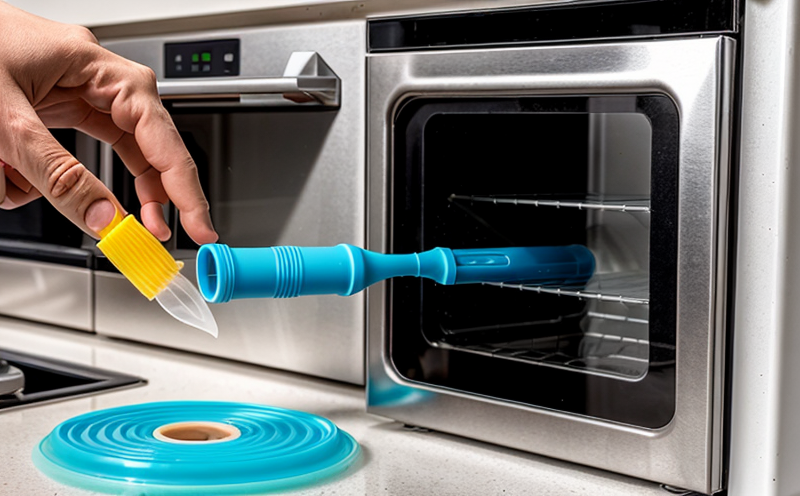ASTM D696 Household Plastics Coefficient of Thermal Expansion Testing
The ASTM D696 method is a critical standard used to measure the coefficient of thermal expansion (CTE) of household plastics. This property is essential for ensuring that materials used in everyday products can withstand temperature fluctuations without deforming or failing. The CTE reflects how much a material expands when heated and contracts when cooled, which is particularly important in household items where exposure to varying temperatures occurs frequently.
Understanding the coefficient of thermal expansion helps engineers design durable, reliable, and safe consumer goods. For instance, this knowledge can prevent issues such as cracks or warping in household appliances, ensuring a better user experience and longer product life. The testing procedure is designed to simulate real-world conditions that these plastics encounter in use.
The ASTM D696 method involves measuring the linear expansion of specimens over a specified temperature range. This process requires precise control of environmental variables like humidity and temperature, which can significantly affect the results if not managed correctly. Proper specimen preparation is also crucial; this includes cutting samples to standard dimensions and ensuring they are free from defects that could skew test outcomes.
Once prepared, specimens are placed in a controlled environment where they are subjected to gradual heating at a constant rate until reaching their final temperature. During this process, the expansion of each sample is continuously monitored using sensitive measurement tools capable of detecting even minute changes in length. Afterward, similar tests are conducted with cooling rather than heating.
The resulting data provides valuable insights into how different household plastics behave under thermal stress. Engineers use these findings to optimize formulations and improve performance characteristics. By adhering strictly to ASTM D696 guidelines, manufacturers ensure consistent quality across batches of products while meeting industry standards for safety and functionality.
It's worth noting that this test is particularly relevant when designing items like food containers, household appliances, toys, and other goods intended for direct contact with consumers. These applications must meet rigorous safety requirements to protect users from potential hazards caused by material failures due to temperature changes.
The accuracy of ASTM D696 results depends heavily on the quality of instrumentation used during testing. High-precision thermocouples or resistance temperature detectors (RTDs) are commonly employed for accurate temperature measurement, while laser interferometers offer precise length measurements required to calculate CTE accurately.
- High-precision thermocouples provide reliable temperature data critical for ASTM D696 compliance.
- Laser interferometers ensure accurate length measurements necessary for calculating the coefficient of thermal expansion.
In conclusion, mastering ASTM D696 enables manufacturers to produce high-quality household plastics that perform reliably across various temperatures. By leveraging this standard, companies can enhance product durability and safety, ultimately leading to better customer satisfaction.
Applied Standards
The ASTM D696 method for measuring the coefficient of thermal expansion (CTE) of household plastics is widely recognized within the industry. It aligns closely with international standards such as ISO 14708 and EN 315, which further validate its relevance in ensuring product quality.
ASTM D696 specifies detailed procedures for preparing test specimens, controlling environmental conditions during testing, and analyzing results to determine the CTE values. These guidelines help ensure consistency across laboratories performing this type of evaluation. Compliance with ASTM D696 not only enhances credibility but also facilitates seamless integration into broader regulatory frameworks.
Additionally, adherence to these standards enables manufacturers to demonstrate their commitment to producing safe, high-performance household plastics that meet both domestic and international requirements. This alignment fosters trust among consumers who rely on dependable products for daily use.
Competitive Advantage and Market Impact
- Innovation Leadership: By staying ahead in adopting ASTM D696, companies can innovate more effectively. This allows them to introduce new products faster, leveraging advanced materials that offer superior thermal stability.
- Better Customer Satisfaction: Ensuring household plastics comply with ASTM D696 reduces the likelihood of defects caused by temperature variations, leading to higher customer satisfaction levels.
- Cost Efficiency: Following stringent testing protocols helps identify potential issues early in development stages, minimizing costly rework or recalls later on.
- Regulatory Compliance: Adhering to ASTM D696 ensures that products meet regulatory requirements, avoiding penalties and enhancing brand reputation.
The implementation of ASTM D696 has far-reaching effects beyond individual companies. It contributes significantly towards maintaining high standards in the household plastics sector, fostering competition based on quality rather than price alone. Consumers benefit from safer, more durable goods, while industry players gain competitive advantages through improved product performance and reliability.
Use Cases and Application Examples
The ASTM D696 method finds extensive application in various sectors where household plastics are used. Here are some key use cases:
- Food Packaging: Ensuring that containers made from polyethylene or polystyrene can withstand temperature changes without compromising food safety.
- Toys & Children's Products: Guaranteeing that materials like ABS or PVC used in children’s toys do not pose risks due to thermal expansion under normal usage conditions.
- Housing Appliances: Verifying the integrity of parts such as handles, lids, and frames found in refrigerators, microwaves, etc., which are exposed to wide temperature ranges during operation.
In each case, ASTM D696 plays a crucial role by providing consistent measurements that help designers optimize material selection. For example, engineers can adjust formulations to enhance thermal stability or reduce weight without sacrificing strength or durability. This flexibility allows manufacturers to balance cost efficiency with product performance effectively.
Furthermore, compliance with ASTM D696 opens up opportunities for companies to participate in global markets where stringent quality controls are enforced. It also supports sustainable practices by promoting the use of recycled materials that maintain similar thermal properties as virgin plastics.





